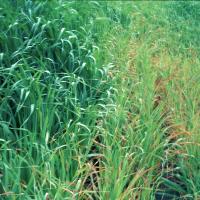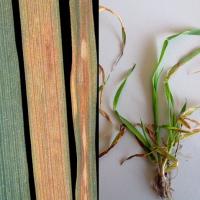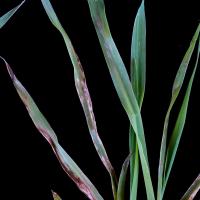Diagnosing zinc deficiency in oats
Oats are more susceptible to zinc (Zn) deficiency than wheat or barley.
What to look for
- Patchy growth, with plants in poor areas.
- Heavily limed soils, sands and gravels or alkaline grey clays tend to be most affected, often in cold wet weather. Plants frequently recover in spring and produce (fewer) normal panicles.
- Zinc deficient crops are often patchy in appearance.
Paddock
- Middle and older leaves turn pale green; pale yellow areas develop between the mid-vein and leaf edge towards the tip. Discolouration spreads downwards and darkens.
- Brown edged spots appear in the affected areas, increasing in size until the leaf tip dies, often turning red-brown to black (main characteristic).
- Base of the leaf remains green, mid section yellow and tips red-brown to black.
- Youngest leaves usually remain green.
- Severely deficient plants have very short stems and young leaves have difficulty emerging fully.
Plant
What else could it be
| Condition | Similarities | Differences |
|---|---|---|
| Diagnosing yellow dwarf virus | Red/yellow leaf colours and necrosis that starts at the tip | Necrotic areas lack red-brown lesions. The disorder tends to be circular or near the edge of the paddock and not associated with soil type |
| Diagnosing potassium deficiency in oats | Unevenly distributed areas of pale plants with tip death, browning and mottling of older leaves | Zn deficiency affects tillers more, leaf tips usually turn red to black and deficiency occurs earlier in cold wet weather, and on limed soils |
Where does it occur?

Soil type

Soil ph
- Most sandy surfaced soils required copper and zinc treatments when initially cleared for agriculture.
- Where soil levels are marginal, zinc deficiency can be induced by applications of lime, high nitrogen fertiliser, and copper fertiliser.
- Zinc deficiency is more common in high pH and clay soils, and on young plants in cold wet weather.
- The use of root-pruning herbicides, particularly groups A and B can induce zinc deficiency.
- Zinc is relatively immobile in soil and can become unavailable to crops in dry soil.
Management strategies

Spraying foliar

Soil application

Seed treatment
- Foliar spray (effective only in current season) or drilled fertiliser.
- A foliar spray of 1kg/ha zinc sulphate (23% Zn) in 50-100L of water should be applied as soon as Zn deficiency is detected to prevent grain and hay yield losses.
- As zinc is immobile in the soil top dressing is ineffective, only being available to the plant when the topsoil is wet.
- Mixing zinc throughout the topsoil improves availability due to more uniform nutrient distribution.
- Zinc drilled deep increases the chances of roots being able to obtain enough zinc when the topsoil is dry.
- Zinc seed treatment is used to promote early growth where root disease is a problem, but the level is lower than a plant needs in the current season.
- Zinc present in compound fertilisers often meets the current requirements of the crop where Zn soil supply is marginal.
How can it be monitored?

Soil test

Tissue test
- A soil test provides at best a rough guide to soil zinc status.
- Whole-top plant test provides a rough guide if paired good/ poor samples are taken, but this should be confirmed with a youngest emerged blade (YEB) test.
- YEB Levels below 14mg/kg indicate zinc deficiency.
See also
Where to go for expert help
Page last updated: Monday, 14 November 2016 - 10:30am




